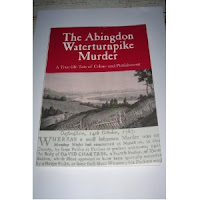I heard about this book several years ago, when the Daily Telegraph (UK) ran an article about 23-year-old Giles
Freeman Covington, a seaman who was hanged in Oxford in 1791 for murdering an
elderly peddler. After the execution his corpse was sent to an anatomy school
for use as a teaching aide. The skeleton ended up as a museum display piece,
and remained so until 2001, when the curator of the Oxford Museum declared his
intention to give the remains a Christian burial. The man added that he questioned
the justice of Covington’s conviction and planned to secure a Royal Pardon.
The Abingdon
Waterturnpike Murder revisits the October 8, 1787 killing of David Charteris,
a Scottish peddler, and the alleged miscarriage of justice that followed.
Charteris was found beaten to death in a ditch at Nuneham, Abingdon, but
primitive police resources and the reluctance of local residents to “get
involved” left the case unsolved for four years.
A break in the investigation occurred when gossip led to the
arrest of one Richard Kilby, an army deserter who offered to tell all in
exchange for a Royal Pardon. He told the authorities that Giles Covington and
an accomplice named Charles Shury had killed Charteris during a robbery attempt
gone wrong.
When Covington’s ship docked in London in 1791 he was
arrested and brought to Oxford to stand trial. He didn’t accept accusation
gracefully: while Kilby was giving evidence, Covington sprang from his seat and
tried to punch him. The jury returned a guilty verdict and three days later, on
March 7, 1791, he was executed at the entrance to Oxford Castle. Before
submitting to the hangman’s deadly art, he tossed a paper off the scaffold: it
was a letter addressed to a local magistrate and read, "I hope you and
your family will live to find that Giles Freeman Covington died innocent and
then I hope you would relieve the widow that is left behind if Bedlam is not to
be her doom."
The Abingdon
Waterturnpike Murder is a slim volume about a murder and aftermath that
weren’t particularly shocking or sensational, but Mark Davies points out that
Covington’s conviction on the basis of an accomplice’s testimony may have been
a miscarriage of justice, and ‘justice denied’ stories have a certain pathos.
The book also provides a fascinating insight into late eighteenth century
social customs and mores. Davies notes in his forward, “Most (of the people who
appear in the book) – ordinary working people of little note – would no doubt
be greatly surprised to find themselves remembered over 200 years later. But
that, I hope is part of the charm of this tale.”
I’m not sure if the Oxford Museum curator went ahead with
the pardon request and, if so, what the outcome was. Apparently a similar
application was made on March 7, 1991 (the 200th anniversary of
Covington’s execution) but a spokesman for the Royal Prerogative of Mercy
division at the Home Office stated, "Normally cases like this involve people
who are still alive and in prison. But the rules are still the same. (The
applicants) will have to produce new evidence to show the original conviction
was unsafe." After over two hundred years it’s unlikely that exculpatory
evidence will ever come to light, but perhaps a public exoneration in this book
will be sufficient.

